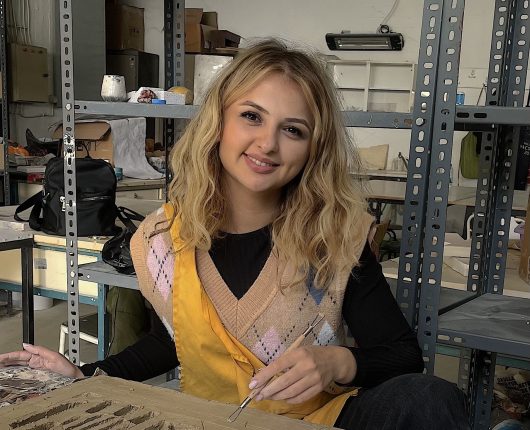RABİA EKİNCİ (Kırşehir, 1995)
Hacettepe Üniversitesi, Seramik Anasanat Dalı
Göçün İzleri / Traces of Migration, 2025
Seramik döküm çamuru, 1050°C, serbest elle ve kalıpla şekillendirme, 23x14x11 cm
Ceramic casting clay, 1050 °C, handbuilt and mold-formed, 23x14x11 cm
“Göçün İzleri” serisi, yaşamın tek bir hücreden başlayan ilk hareketinden embriyonun bedensel gelişimine ve varoluş dönüşümüne uzanan süreci konu alır. Her parça, anne karnındaki fetüsün göbek bağı aracılığıyla kurduğu ilk yaşam bağından ilhamla, bireysel içsel yolculukların ve insan topluluklarının tarih boyunca süregelen göç deneyimlerinin metaforik bir ifadesine dönüşür. Organik yüzeyler ve kordon benzeri hatlar yalnızca biyolojik bir bağı değil; kopma ve yeniden bağlanma, bellek ve köklerle kurulan görünmez ilişkileri de simgeler. Bu bağlar, aidiyet, ayrılma ve yeniden tutunma süreçlerini seramik formda görünür kılar. Seramik malzeme, içsel ve kolektif yolculuğu somut bir dile çevirerek göçün hem kırılgan hem de dayanıklı doğasını ortaya çıkarır.
The “Traces of Migration” series explores the journey from the very first movement of life, beginning with a single cell, to the bodily development of the embryo and the transformation of existence. Each piece, inspired by the first vital connection formed through the umbilical cord in the womb, becomes a metaphor for both personal inner journeys and the collective migration experiences of human communities throughout history. The organic surfaces and cord-like lines symbolize not only the biological bond but also the invisible connections of detachment and reconnection, memory, and ancestral roots. These ties make processes of belonging, separation, and reattachment visible in ceramic form. Through this material language, ceramic transforms both the intimate and collective voyage into a tangible expression, revealing the fragile yet resilient nature of migration.
Sanatçı ve eserle ilgili daha fazla bilgi almak için info@base.ist adresine e-posta atmanızı rica ederiz.
“Göçün İzleri” serisi, yaşamın tek bir hücreden başlayan ilk hareketinden embriyonun bedensel gelişimine ve varoluş dönüşümüne uzanan süreci konu alır. Her parça, anne karnındaki fetüsün göbek bağı aracılığıyla kurduğu ilk yaşam bağından ilhamla, bireysel içsel yolculukların ve insan topluluklarının tarih boyunca süregelen göç deneyimlerinin metaforik bir ifadesine dönüşür. Organik yüzeyler ve kordon benzeri hatlar yalnızca biyolojik bir bağı değil; kopma ve yeniden bağlanma, bellek ve köklerle kurulan görünmez ilişkileri de simgeler. Bu bağlar, aidiyet, ayrılma ve yeniden tutunma süreçlerini seramik formda görünür kılar. Seramik malzeme, içsel ve kolektif yolculuğu somut bir dile çevirerek göçün hem kırılgan hem de dayanıklı doğasını ortaya çıkarır.
The “Traces of Migration” series explores the journey from the very first movement of life, beginning with a single cell, to the bodily development of the embryo and the transformation of existence. Each piece, inspired by the first vital connection formed through the umbilical cord in the womb, becomes a metaphor for both personal inner journeys and the collective migration experiences of human communities throughout history. The organic surfaces and cord-like lines symbolize not only the biological bond but also the invisible connections of detachment and reconnection, memory, and ancestral roots. These ties make processes of belonging, separation, and reattachment visible in ceramic form. Through this material language, ceramic transforms both the intimate and collective voyage into a tangible expression, revealing the fragile yet resilient nature of migration.
Sanatçı ve eserle ilgili daha fazla bilgi almak için info@base.ist adresine e-posta atmanızı rica ederiz.

